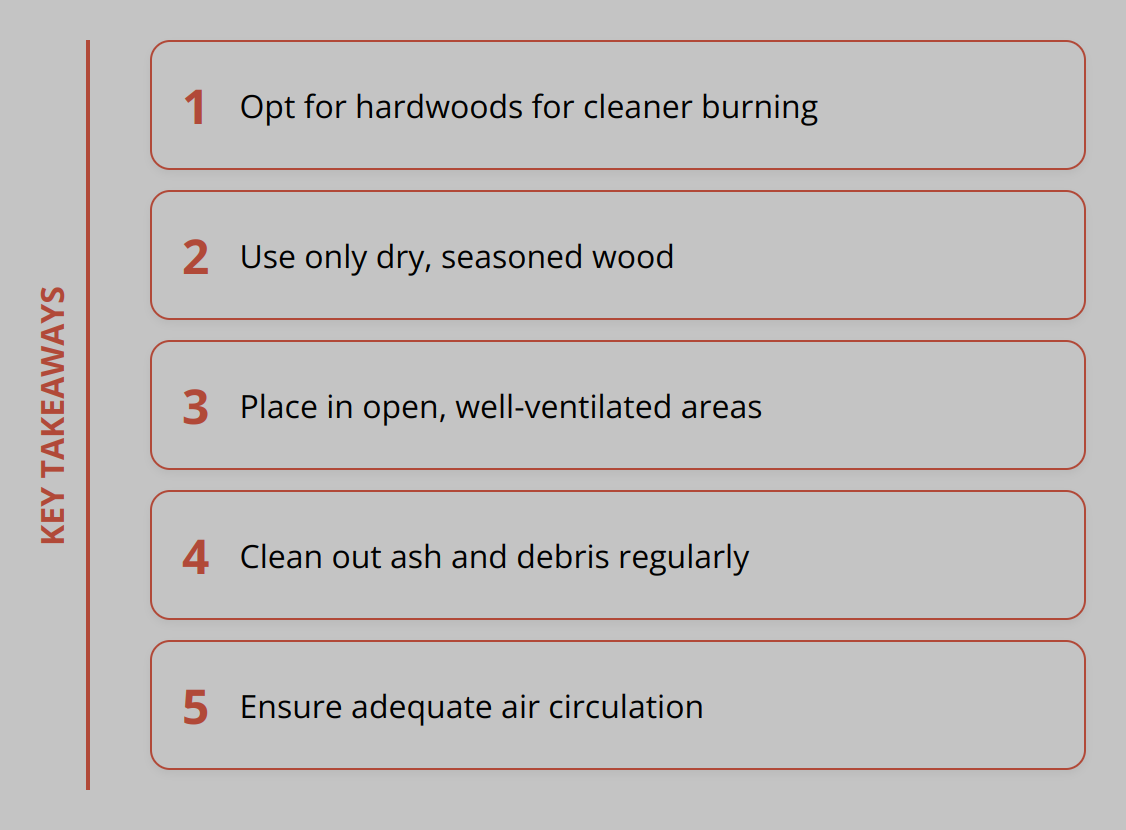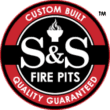
Smoke irritation from fire pits can put a damper on what should be a relaxing experience. Understanding and mitigating this concern is vital for both comfort and health.
At S&S Fire Pits, we believe in empowering our customers with knowledge and practical solutions. This blog post walks through the essentials of smoke irritation and offers tips to enhance your fire pit experience, making it more enjoyable and safe for everyone involved.
Why Does Smoke Irritate?
Smoke irritation occurs because the smoke contains a variety of particles and chemicals that can affect the eyes, nose, throat, and lungs. When you sit around a fire pit, exposure to smoke can lead to several unpleasant symptoms, making it vital to understand not just why this irritation happens, but also how to avoid or minimize it.
Firstly, smoke irritation can arise from the combustion of different materials. Wood smoke, which is most common in fire pits, consists of fine particles, gases, and volatile organic compounds (VOCs). These substances can provoke irritation in the respiratory system and eyes. This is particularly true if the wood is not completely dry or is of a type that produces more smoke, like softwoods.
The common symptoms of smoke exposure include coughing, difficulty breathing, watery eyes, and a sore throat. In individuals with pre-existing conditions like asthma or allergies, these symptoms can exacerbate, leading to more severe health issues.
Different types of smoke can cause varying levels of irritation. For instance, smoke from natural wood tends to be less harmful compared to synthetic materials or treated wood, which can release toxic chemicals into the air. Knowing the source of your fire pit’s fuel is essential in controlling the situation.
To help manage and reduce the risk of smoke irritation, consider these practical steps:
- Use dry, untreated wood: Moisture and chemicals in wood can increase smoke production. Opt for hardwoods like oak or ash for a cleaner burn.
- Improve air circulation: Positioning the fire pit in an area with good airflow helps disperse smoke more quickly.
- Limit exposure: Sit at a safe distance from the fire pit to minimize direct smoke inhalation.
- Use a smokeless fuel alternative: Products like natural gas or propane can provide a flame without the smoke.

For those looking to dive deeper into safe and enjoyable fire pit experiences, navigating the nuances of smoke in your fire pit can offer valuable insights. Furthermore, understanding how to stop campfire from smoking can also be beneficial for those enjoying outdoor adventures.
Addressing smoke irritation effectively ensures your time spent around the fire pit remains pleasurable and safe. By applying these actionable tips, you can significantly reduce the impact of smoke on yourself and your loved ones.
Avoiding Smoke Irritation
Creating an environment that minimizes smoke irritation significantly enhances the quality of your outdoor experiences. This focus on both preventive steps and immediate remedies ensures that your gatherings around the fire pit or any outdoor activities remain enjoyable and health-friendly.
Creating a Smoke-Free Environment at Home
Ensuring your home remains a sanctuary against smoke starts with optimizing ventilation. Regularly open windows and use exhaust fans to circulate fresh air, reducing indoor smoke accumulation. Additionally, investing in high-quality air purifiers can be a game-changer, especially models with HEPA filters that capture fine particles from the air. For those living in areas prone to wildfire smoke or other pollutants, this can make a significant difference in indoor air quality.
Another often overlooked aspect is the maintenance of HVAC systems. Ensure these systems are properly serviced and that filters are regularly replaced to prevent smoke and particulates from circulating indoors. This practice also extends to the maintenance of any indoor fireplaces. Ensure they are well-vented and cleaned regularly to prevent indoor smoke issues.

Tips for Reducing Smoke Exposure Outdoors
When engaging in outdoor activities, location and timing are key. Choose locations away from known smoke sources and plan activities for times when air quality is better. This can be early morning or late evening, depending on local conditions. Websites providing real-time air quality information can be invaluable tools for this planning process. Monitoring platforms like AirNow can guide decisions about outdoor activities based on current air quality readings.
For those who enjoy camping or outdoor cooking, selecting the right fuel is critical. Using dry, seasoned wood or smokeless fuel alternatives for campfires and cooking can dramatically reduce smoke production. Remember, the goal is to achieve a clean burn, significantly limiting the amount of smoke released into the air.
Turning activities indoors or seeking locations with clean air filtration systems during days of poor air quality are also smart moves. Public buildings like libraries or community centers often have advanced air filtration systems that can offer a reprieve from outdoor smoke.
Importance of Protective Gear and Air Filification
During unavoidable exposure to smoke, wearing protective masks designed to filter out fine particles can provide a line of defense. N95 respirators, for example, are effective at filtering out harmful particles in smoke. However, it’s essential to wear them correctly for them to be effective.
Utilizing portable air filtration systems in personal and communal outdoor spaces can also create cleaner air zones. These systems can provide a barrier of protection, reducing the inhalation of harmful particles for those gathered around.
Lastly, staying informed and prepared is fundamental. Understanding the dynamics of smoke and how it affects air quality and health allows for better preparation and response to minimize exposure and potential health risks.
In summary, minimizing smoke irritation involves a combination of strategies aimed at reducing direct exposure, improving air quality, and employing protective measures when needed. By adopting these practices, individuals can enjoy outdoor activities with minimized health risks associated with smoke inhalation.
Reducing Smoke from Your Fire Pit
When it comes to minimizing smoke irritation from fire pits, the key lies in three main areas: choosing the right fuel, optimal placement, and regular maintenance. Let’s dive into actionable insights that can drastically improve your fire pit experience.
Right Fuel Equals Less Smoke
The type of fuel you choose can significantly impact the amount of smoke your fire pit produces. Hardwoods, such as oak, hickory, and ash, are denser and burn more completely than softwoods like pine or cedar, resulting in less smoke. It’s not just about selecting the right type of wood but also ensuring that it’s well-seasoned and dry. Moisture in wood leads to incomplete combustion, which increases smoke output. For an eco-friendlier option, consider manufactured logs made from recycled sawdust and wax; they burn cleaner and produce minimal smoke.
- Opt for hardwoods for cleaner burning
- Use only dry, seasoned wood
- Consider eco-friendly manufactured logs

Fire Pit Placement Matters
Where you place your fire pit can drastically affect your exposure to smoke. Always set up your fire pit in open areas where there’s enough airflow to disperse smoke. Avoid enclosed or partially enclosed spaces like covered patios or under low-hanging tree branches, as these can trap smoke, making it linger longer. A strategically placed fire pit not only minimizes smoke irritation but also enhances safety by reducing the risk of fire hazards.
- Place in open, well-ventilated areas
- Keep away from enclosed spaces
- Avoid positioning under overhangs or trees
Maintenance for Cleaner Burning
Regular maintenance of your fire pit is vital for ensuring it burns cleanly and efficiently. Removing excess ash and debris from previous burn sessions can significantly improve air circulation within the fire pit, promoting a more complete combustion process that generates less smoke. Additionally, inspect your fire pit for any signs of damage or wear that could affect its functionality. Proper care and maintenance not only extend the lifespan of your fire pit but also contribute to a safer and more enjoyable outdoor experience.
- Clean out ash and debris regularly
- Inspect for damage or wear
- Ensure adequate air circulation
By focusing on these practical steps, you can significantly reduce smoke production from your fire pit, creating a more enjoyable and irritating-free atmosphere for your outdoor gatherings. Remember, the key to a great fire pit experience is not just about controlling smoke but also about embracing safety and environmental responsibility. For more detailed insights into maintaining your fire pit, maintaining your home fire pit offers comprehensive guidance.
Final Thoughts
Smoke irritation from fire pits, while a common concern, can be significantly mitigated with the right knowledge and tools. By choosing the appropriate fuel, ensuring optimal placement, and performing regular maintenance, you can drastically reduce smoke production and enhance your outdoor living experience. Awareness of the sources of smoke and its effects on health is essential in creating a safe and enjoyable environment for everyone.

Proper fire management plays a pivotal role in this process. It’s not just about reducing irritation but also about promoting safety and environmental responsibility. Adopting practices such as using dry, untreated wood and positioning your fire pit in well-ventilated areas are straightforward yet effective steps toward achieving a cleaner burn.
At S&S Fire Pits, we are committed to enriching your outdoor gatherings by providing handcrafted, durable fire pits that embody both quality and style. Our range of products, from the popular 37” hemisphere to decorative elliptical fire pits, cater to various preferences and settings. We believe that with the right fire pit and adherence to best practices, every outdoor moment can be transformed into a cherished memory.
We encourage everyone to prioritize safety and enjoyment by staying informed and prepared. Whether it’s a quiet evening with family or a lively gathering with friends, managing smoke effectively means more time enjoying the warmth and less time worrying about irritation.
For those interested in enhancing their fire pit experience and exploring our collection, visit S&S Fire Pits. Let us help you elevate your outdoor living space with our handcrafted creations, made with pride and designed for life.


